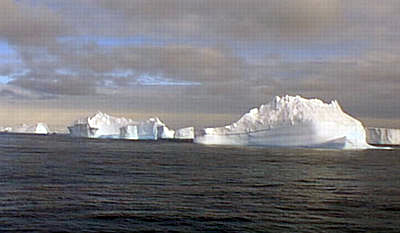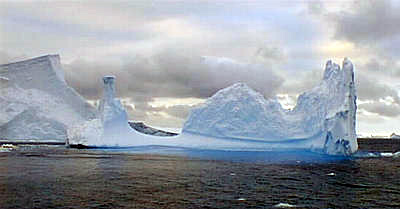14 March, 1999
March 14, 1999
Greetings from the Nathaniel B. Palmer! We have spent all of today in
transit across the Bellingshausen Sea. By morning, we should arrive at
Eltanin Bay. Eltanin Bay is rarely ice-free, but this year is an
exception. As result, we have modified our plans to spend a day or two
conducting a multibeam survey of the area and collecting a few piston
cores. This area is a major drainage outlet for the West Antarctic Ice
Sheet, and we are hoping to learn more about the local glacial retreat
history through our study.
In the daily journals, I've spent quite a bit of time telling you about the
different people aboard the Nathaniel B. Palmer. So far, we've discussed
most of the scientists and all of the Edison Chouest Offshore employees who
make up the crew of the ship. There is still another set of employees . .
. those people employed by Antarctic Support Associates (ASA). ASA is an
organization contracted by the National Science Foundation to help support
the scientific operations in Antarctica. They are in charge of medical
clearances, transportation, electricity, water, housing, facilities, and
equipment (to name only a very few things). Scientists can't come and work
in Antarctica without lots of help. ASA is in charge of all that help! On
the Nathaniel B. Palmer, there are ten ASA employees. Which employees come
to Antarctica depends on what science is being conducted with that
parcticular project. They all have different responsibilities, but they are
all under the direction of the Marine Projects Coordinator.
The Marine Projects Coordinator (MPC) on our cruise is Don Michaelson. Don
and his wife live in Denver, Colorado. Actually, Don is the Marine
Superintendent at Antarctic Support Associates. He's working as the MPC on
this cruise, but this is not his normal job. As the Marine Superintendent,
Don is in charge of all the MPCs. He also discusses job responsibilities
with Edison Chouest Offshore, the company that owns the ship. Don helps to
figure out which company is responsible for which pieces of equipment on
the ship.
Don graduated with a degree in electronics at Southern Illinois University.
He has held a variety of jobs since his college graduation. He has been a
radio disc jockey, a bomb shelter inspector, an electrician for the Air
Force, the owner of a blueberry farm, a truck driver who delivered candy
across the United States, and a person who fights forest fires in the
Pacific Northwest. For the last eight years, he has worked on or around
ships as a Marine Technician or an MPC. He's been with Antarctic Support
Associates for three years, and loves the opportunities for travel that
come with his position. He also really likes the other people that he gets
to work with.
As the MPC on this cruise, Don coordinates the science project. MPCs make
sure that the right cargo, equipment and staff are ready for the science
project (or projects) of each parcticular cruise. They also organize all of
the required forms, acquire the necessary permits, and make arrangements
for the airline tickets. In addition, the MPC is the supervisor for the
other Antarctic Support Associates employees on board the ship, and they
are the liason between the scientists and the ECO crew.
Now let's spend some time looking at the answer to yesterday's question.
It was, "What are the Dry Valleys?" They are some of the most unusual
places on Earth! It is believed that they are the nearest equivalent on
Earth to the terrain of Mars. In fact, NASA conducted extensive research
in the Dry Valleys before launching the Viking probe to Mars. No rain has
fallen in the dry valleys for at least two million years. They are the
driest place on our planet.
There are actually three main Dry Valleys, which are named Victoria,
Wright, and Taylor from the north to the south. They cover 1,160 square
miles of Antarctica, and are found on the eastern side of McMurdo Sound.
There are other, smaller, dry valleys on the eastern side of the continent.
The Dry Valleys have no snow or ice, which is the reason for their name.
The Transantarctic Mountains have continued uplifting since they were first
formed. In some areas, the land has uplifted over the past 30 million
years at a faster rate than the glaciers could cut their way down. The
result is an area where the glaciers are unable to flow into the valleys.
Another factor adding to the dryness of the Dry Valleys is the extremely
dry winds that move through the valley floors. The winds often exceed 62
miles per hour and have a relative humidity of less than ten percent. This
would cause the sublimation (going from a solid to a gas) of any snow that
might be brought into the valleys. There are a few meltwater streams and
lakes that can be found in parts of the Dry Valleys during the summer.
These lakes and streams, however, are only flowing for a few short weeks
each year. As the winds blow and the temperatures drop, the water
evaporates . . . leaving the valleys totally dry once again. These high
winds are so strong that they erode and sculpt the rocks into very bizarre
shapes that are called ventifacts. Mummified seals can also be found in
the Dry Valleys. They are effectively freeze-dried after the seals
apparently got lost and couldn't find their way back to the ocean.
Well, that's about all we have time for today. I've had lots of people
send email questions asking about the aurora australis. What is the aurora
australis? We'll look at that in tomorrow's journal. By the way, we moved
our clocks forward another hour today, so now we are on the same time as
the eastern coast of the United States (and Indiana). I hope you're
enjoying the great iceberg pictures I'm sending home . . . they sure are
neat to see out the portholes!
Kim Giesting
Latitude: 71 degrees 27 minutes South
Longitude: 89 degrees 29 minutes West
Temperature: -3 degrees C
Barometer: 968.1 mb
Wind Speed: 25.1 knots
Wind Direction: 135 degrees (from the Southeast)
Sunrise: 05:54
Sunset: 18:44

Don Michaelson is our Marine Projects Coordinator. Here's Don working in his office.

. . . and plentiful in this area!!

The icebergs are gorgeous . . .
Contact the TEA in the field at
.
If you cannot connect through your browser, copy the
TEA's e-mail address in the "To:" line of
your favorite e-mail package.
|
